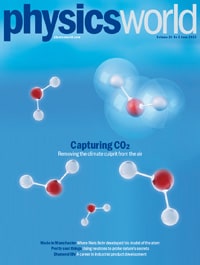
By Matin Durrani
As physics has grown into a bigger, increasingly global and more connected endeavour, are there still any true physics hot spots? Are there any institutes, universities or regions that really are “the place to be”? Does good physics, in other words, depend more on who (or what) you know than where you are?
The importance of having the right people in the right location is well illustrated in this month’s issue of Physics World, in which science writer Brian Clegg looks at the role played by Manchester in the development by Niels Bohr of his model of the atomic nucleus 100 years ago.
What drew Bohr there were not so much the facilities at the University of Manchester’s physics department but rather its working environment and in particular the presence of the New Zealander Ernest Rutherford, with whom Bohr struck up a great rapport.
Our cover story this month concerns attempts to extract carbon dioxide from the air in the fight against climate change, while elsewhere in the issue we look at all the cool – and pretty fundamental – things you can do with ultracold neutrons.
Members of the Institute of Physics can access the entire new issue online free through the digital version of the magazine or by downloading the Physics World app onto your iPhone or iPad or Android device, available from the App Store and Google Play respectively.
If you’re not yet a member, you can join the Institute as an IOPimember for just £15, €20 or $25 a year. Being an IOPimember gives you a full year’s access to Physics World both online and through the apps.
For the record, here’s a rundown of highlights of the issue:
• UK makes a FAIR U-turn – After having largely pulled out of the FAIR nuclear-physics facility in Germany, the UK has now backtracked and taken up associate member status at the lab, as Michael Banks reports
• Glimpsing a new particle – A little over a year after discovering Majorana-like fermions in a nanowire, Leo Kouwenhoven hopes they could one day be used in a quantum computer, as he tells Martijn van Calmthout
• A divided union? – Public investment in research in the EU is at a crossroads. Former Portuguese science minister José Mariano Gago argues that the focus should now be on national budgets
• The new idols – What would be on Francis Bacon’s list of idols today? Robert P Crease seeks your thoughts and ideas
• Cool things to do with neutrons – Testing basic principles of particle physics does not necessarily require a high-energy accelerator. As Peter Geltenbort explains, a growing community of neutron scientists is probing similarly fundamental problems at the opposite end of the energy scale
• Made in Manchester – Brian Clegg describes how the young postdoc Niels Bohr developed his famous model of the atom, published 100 years ago, after he had a productive stay with Ernest Rutherford in Manchester
• Mopping up carbon – Technologies that capture carbon dioxide directly from the air would help us to manage climate change and make profitable by-products in the process. But the financial feasibility of such schemes is controversial, as David Appell reports
• Structural disputes – Athene Donald reviews I Died for Beauty by Marjorie Senechal
• It’s that particle again – Patrick Fox reviews The Particle at the End of the Universe by Sean Carroll
• The sixth element – Stephanie Liggins‘ PhD research on defects within the structure of diamonds led her to a career in industrial product development
• Once a physicist – Janet Guthrie describes how she evolved from physicist to racing driver
• Some overlooked basic principles – Aaron Leonard muses on life’s little missing rules of everyday life in this month’s Lateral Thoughts column
Finally, don’t miss our embedded video clips that are scattered throughout the issue on pages 5, 23, 34 and 43.
Enjoy the issue – and do let me know your thoughts by e-mailing pwld@iop.org.



